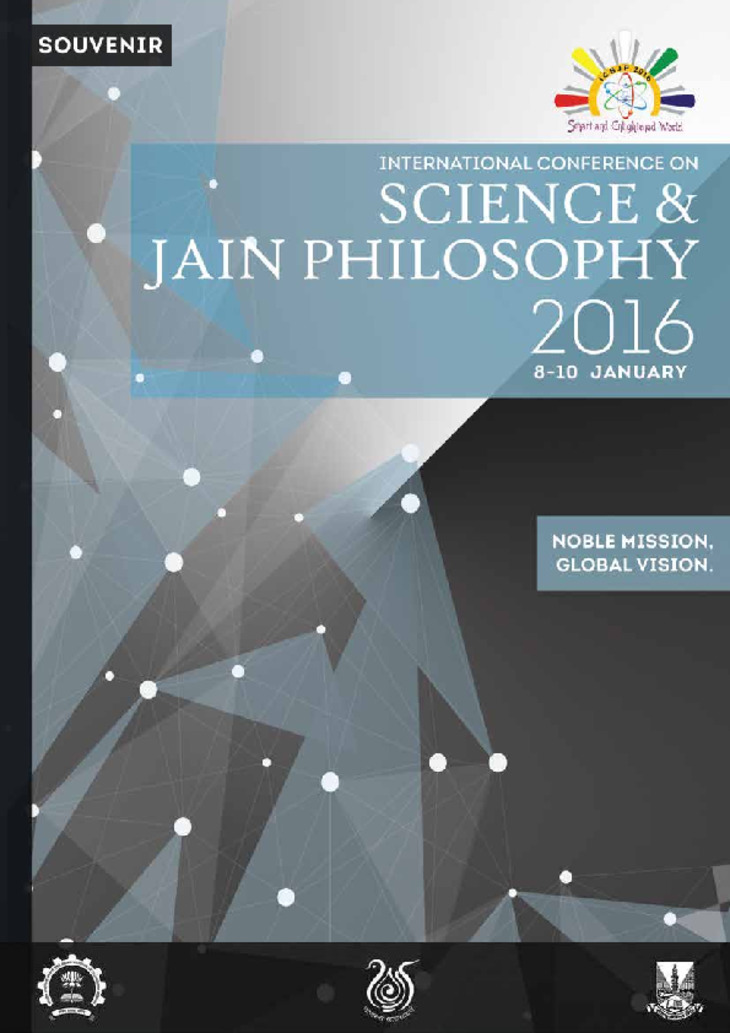
International Conference on Science and Jain Philosophy
 Prof. Dr. Kanti Mardia is a Jain scholar, a Senior Research Professor of Statistics at the Leeds Univ. and Oxford Univ. He has many Jain published works to his credit including The Scientific Foundations of Jainism and, and recently launched the Album on his Jain thoughts with the Late Ravindra Jain (Bollywood Celebrity).
Prof. Dr. Kanti Mardia is a Jain scholar, a Senior Research Professor of Statistics at the Leeds Univ. and Oxford Univ. He has many Jain published works to his credit including The Scientific Foundations of Jainism and, and recently launched the Album on his Jain thoughts with the Late Ravindra Jain (Bollywood Celebrity).
1. Introduction
One of the fundamental concepts of Jain Science of Life is 'The soul exists in contamination with karmic matter and it Longs to be purified'. Further, the karmic matter gets differentiated into eight karmic components/karmas (Mula Karmaprakriti). The eight types in standard sequence ordering are shown in Table 1 and divided into two groups: the first four Ghatiyas (negatively influencing the soul quality) and the next four Aghatiyas (their presence does not interfere with Keval Gyan and are connected with embodiment). The major systematic treatment includes that of Davendra Suri's "Karmagranthas" and Nemichandra's "Gommatasara" (Karma-Kanda, NS1 = the first stanza below); we refer below to Gommatasara.
2. New Modern Treatment
There have been many different literal English translations of the above key words, leading to several variations. For example, Ghatiya and Aghatiya Karma are translated as Destructive and Non-destructive Karma (P. S. Jaini's Book), and as Harmful and Non-harmful (Dunda's Book). These do not capture their functional essence in terms of modern scientific and psychology thinking. Kachhara (2014, Scientific Explorations of Jain Doctrines) seems to have taken the first step towards projecting them into modern thinking and thus taken an out-of-the-box approach, namely, he uses Psychical for Ghatiya, and Biological and Physiological for Aghatiya.
However, we start differently; first, we start translating Ghatiyas and Aghatiyas in a functional way, so their intrinsic properties are brought closer to their action as Ghatiyas is more active and observable than Aghatiyas (which is passive/latent) in a particular life-span. Thus, we equate the Ghatiyas as some form of quotient-blocking karma, whereas Aghatiya as coding karma. This nomenclature has the following additional advantages:
(i) that quotients are quantifiable as most of these karmas are in terms of pudgala and these are active in operation, whereas coding's are mostly collecting information for the next incarnation and are otherwise passive in one's life-time.
(ii) Further, we extend the idea and translate eight of these karmas as in Table 1.
- Emotional Quotient blocking (EQB);
- Executive Quotient blocking (XQB);
- Intelligence Quotient blocking (IQB);
- Spiritual Quotient blocking (SQB);
- Psyche coding (PC);
- Bio coding (BC);
- Actuarial coding (AC);
- Environmental coding (EC).
These differ from Kachhara's nomenclature of these eight karmas but the aim is similar. Our system tries to unify the concept of the types of the eight karmas as well as describing their functional properties in a broad sense. For example, we can measure emotions, knowledge, executive ability and spiritual strength, but in contrast we don't know what the four embodiment factors are coded for the next life.
In a way, Quotients reflects qualities of the Soul (Mardia's Book) as given in Table 1; the higher the life quotients, lower the karmic matter. In contrast, the first four karmic components reduce the Quotients by defiling, obstructing or obscuring the inherent elements of the Soul. The Coding's are rules that define an individual,
The abbreviations EQ and IQ are well-known, XQ and SQ are not. XQ is also known as virya, or the quality of energy, and the generator of the vibrations of body, mind and speech. SQ is controlled perception, and measures a person's spiritual level. It is high in a person with divine qualities, for example, it is the highest in Tirthankaras. SQ increases as this karmic matter is at zero level.
The Genetic Coding is well-known, but not Bio Coding. The Jain interpretation of Bio Coding, however, goes well beyond mere DNA - it includes codes for heavenly beings and beings from hell, in addition to codes for earthly beings, both human and animal. The Psyche Coding is a major part of "personality". The Environmental Coding is related to what is conducive or non-conducive for a Jiva. The Actuarial Coding is deemed to be the length of life span of a Jiva.
3. Nemichandra's examples of the eight Karmas and our model
Here now we give the traditional sequence ordering in Table 2 (using Roman numerals) and the mapping (NS21) between this and the standard sequence.
Table 3 gives examples used by Nemichandra to illustrate each of the eight karmas. We now demonstrate that they fit closely with our terminology, capturing the essential features and functions sequentially.
As one cannot get true knowledge of a deity on obscuring the sight by covering the face of the deity, in the same way the IQ is blocked. As the guard on duty prevents sight of the king, in the same way the perception of the SQ is blocked. Licking a sword coated with honey, first one gets a pleasant taste, but then the sword's edge cuts the tongue and causes pain. In the same way, the psyche coding karma causes fluctuation between pleasure and pain. Just as one gets careless under the influence of alcohol, in the same way the emotional quotient blocking karma reduces the value/level of the EQ. In the way a chained person cannot moue, so the actuarial coding karma restricts one to a particular existence. As the painter can paint/portray various pictures, in the same way bio coding karma gives a jiva the form of a human or hellish being. In the way the potter is able to make pots of different size and glaze (for different uses), the environmental coding karma creates a conducive or non-conducive environment for jiva. As the treasurer does not allow the king to execute his desire to give to charity, so the executive bonding karma prevents the execution of positive activity.
NS18-20 give explanation of this sequential order of their operation. For example, this gives blocking karma IQ the main role, followed by blocking karma SQ, Psyche Coding and blocking karma EQ; thus the Psyche Coding plays a role at a higher level than the blocking karma XQ. This follows common empirical observation, though blocking karma EQ is regarded as the leader of all karmas.
4. Concluding Remarks
As far as I know not much has happened on these lines, and we quote from the thesis of Wiley (2000) for some possible reasons:
"However, in spite of the importance of karma theory.... There seems to have been a reluctance to examine critically this vast and highly technical body of material, which most would characterize as one of the more tedious parts of what has been viewed historically to be a lackluster corpus of literature."
On the other hand, modern thinkers have been trying to understand consciousness and we give the following quote of Gallen Strawson (Economist, 3-10-15). 'It is beyond serious doubt that conscious experience is wholly a matter of brain activity, but this doesn't show us that we don't know what consciousness is. It shows us that we don't know what matter is. The hard problem is the problem of matter. Matter is even more extraordinary than we thought, as physicists have been demonstrating for a long time.' In this the search for matter alludes to something with properties akin to karmic matter though the field is still wide opens as far as scientists are concerned. Our new model gives some insight but further research is needed.
Acknowledgement: I wish to express my thanks to Kristi Wiley for her help.
Table 1: The eight karmic components (Mula karma-prakriti)
| Negative forces/karmic components | New nomenclature | Quotients / Elements of the Soul | |||
| Primary components (destructive or Ghatiya in this cycle) = Four Quotients | 1 | Bliss-defiling 1a = insight- deluding, 1 b = conduct- deluding (with four Kashayas and nine subsidiary Kashayas) | Mohaniya | EQ blocking karma | Bliss |
| 2 | Energy-obstructing | Antaraya | XQ blocking karma | Energy | |
| 3 | Knowledge- obscuring | Jnana- avaraniya | IQ blocking karma | Knowledge | |
| 4 | Perception- obscuring | Darsana- avaraniya | SQ blocking karma | Perception | |
| Secondary components (non-destructive or aghatiya in this cycle) = Four Codes | 5 | Feeling-producing 5a = generator of pleasant feelings 5b = generator of unpleasant feelings) | Vedaniya | Psyche coding karma | |
| 6 | Body-producing | Nama | Bio coding karma | ||
| 7 | Longevity- determining | Ayu | Actuarial coding karma | ||
| 8 | Environment- determining | Gotra | Environmental coding karma | ||
Table 2: Operational order of karmic components
G or Ghatiya = Primary and destructive. A or Aghatiya = Secondary and nondestructive. Roman numerals show traditional sequence; Hindu numerals in brackets show corresponding standard sequence
| I(3) | Knowledge-obscuring (G) | Jnana-avaraniya | IQ blocking karma |
| II(4) | Perception-obscuring (G) | Darsana- avaraniya | SQ blocking karma |
| III(5) | Feeling-producing (A) | Vedaniya | Psyche coding karma |
| IV (1) | Bliss-defiling (G) | Mohaniya | EQ blocking karma |
| V(7) | Longevity- determining (A) | Ayu | Actuarial coding karma |
| VI (6) | Body-producing (A) | Nama | Bio coding karma |
| VII (8) | Environmental- determining (A) | Gotra | Environmental coding karma |
| VIII (2) | Energy- obstructing (G) | Antaraya | XQ blocking karma |
Table 3 - The traditional order of the eight karmas and their examples (Nemichandra's Stanza 21, Gommatasara, Karam-Kanda, Translation: J.L. Jaini)
| I | IQ blocking karma | Jnana- avaraniya | The veil (which obscures the sight of the face) |
| II | SQ blocking karma | Darsana- avaraniya | The guard on duty (who prevents sight of the King) |
| III | Psyche coding karma | Vedaniya | The sword (coated with honey; licking it, the tongue is cut, 1 so that the pain is more than the pleasure) |
| IV | EQ blocking karma | Mohaniya | Wine (which intoxicates and deludes) |
| V | Actuarial coding karma | Ayu | The stocks (which confine one to a certain condition) |
| VI | Bio coding karma | Nama | The painter (who makes different kinds of portraits) |
| VII | Environmental coding karma | Gotra | The potter (who turns out tall and low pitchers) |
| VIII | XQ blocking karma | Antaraya | The treasurer (who obstructs the king in giving money in charity) |
 Prof. Dr. Kanti V. Mardia
Prof. Dr. Kanti V. Mardia
